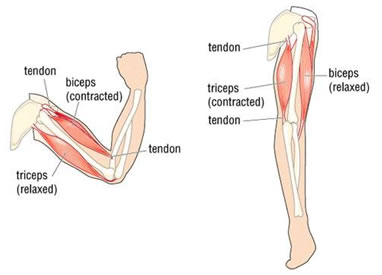Muscles need to work together to move the arm and keep the joints in a good position. In order to bend and straighten your arm you need one set of muscles to slowly bend and the opposite ones to slowly relax/release.

Diagram showing muscle contraction and relaxation
If one set of muscles work and the others don’t then the limb will be pulled in one direction. Sometimes following a stroke some of the muscles work without the brain controlling them (increased tone). This can cause an abnormal increase in the stiffness/tone of one set of muscles with no control in the opposite muscles. So for example the arm may bend without control if this problem occurs then the arm may stay in a bent position.
Problems that occur from a stiff arm are:
- Loss of movement. Stiffness of muscles prevents the muscles working properly and therefore they cannot move the arm. This lack of movement means that the arm and joints can become difficult to move. When a joint does not move regularly then it can become stiff. When the arm is therefore moved it can cause discomfort and pain. Additionally when muscles are not moved regularly they can become permanently shortened or contracted. This loss of movement, joint stiffness and pain may make it difficult for a person to do everyday tasks like get dressed, wash under their armpit etc.
- Tight hand and curled fingers. When the muscles of the hand have increased tone then they tend to pull the wrist in and curl the fingers in towards the palm. It may be difficult to open the hand out and get access to the palm especially to give it a clean and look after the skin. Pain may be felt when the fingers are moved.